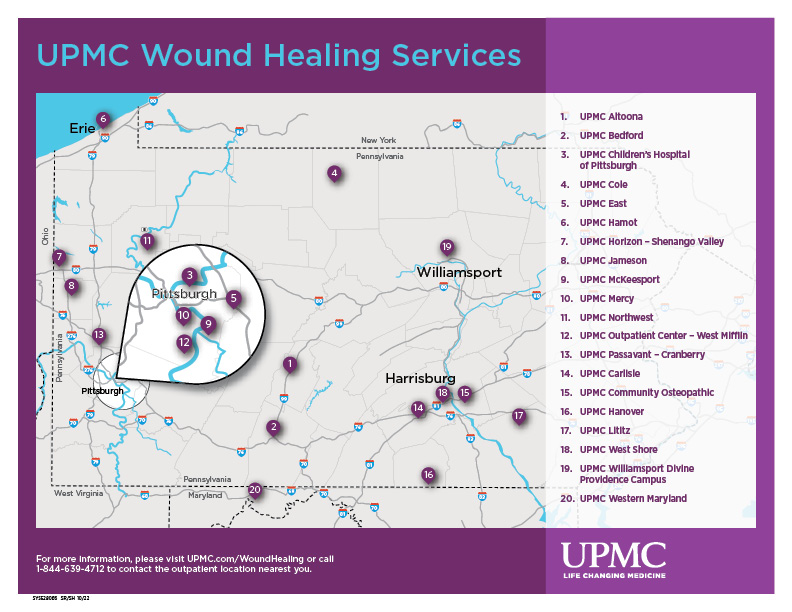UPMC Wound Healing Services provides a wide variety of wound healing options in 20 different outpatient locations around Pennsylvania and Maryland.
Wound healing is an inclusive term. It means any method of alleviating pain and promoting healing in a wound caused by disease, surgery, or trauma.
Wound healing is an option for wounds that have not healed about 50% in four weeks or that have not healed completely after eight weeks.
Most UPMC Wound Healing Services locations are in a hospital-based setting with state-of-the-art technology. Every UPMC wound healing location comes with a team of providers to give you a comprehensive, customized treatment plan.

Never Miss a Beat!
Subscribe to Our HealthBeat Newsletter!
Thank you for subscribing!
You can now select the specific newsletters you'd like to receive.
You are already subscribed.
Subscribe to more newsletters in our email preference center.
Sorry, an error occurred. Please try again later.
Get Healthy Tips Sent to Your Phone!
What Causes Wounds that Won’t Heal?
There are many causes of chronic wounds, which is a skin wound that doesn’t heal, heals slowly, or heals but comes back.
The most common causes of chronic wounds include:
- Pressure injuries.
- Trauma.
- Burns. Skin cancers.
- Infections.
- An underlying medical condition, such as diabetes and vascular disease.
Wounds that take a long time to heal need special care.
Wound Healing and Limb Preservation
Wound healing is important for those with chronic wounds because chronic wounds can lead to amputation. The World Health Organization estimates that nearly 85% of amputations are preventable.
For example, diabetes can lead to peripheral artery disease (PAD). This causes blood vessels to narrow and reduces blood flow to the legs and feet. It also may cause peripheral neuropathy, which is nerve damage. With nerve damage, you may not feel a sore on your foot until it has become infected.
Reduced blood flow can slow wound healing and make the body less effective at fighting infection. As a result, your wound may not heal. Tissue damage or death may occur, or an existing infection may spread to your bone. When this happens, you may need amputation of the extremities to save the limb.
Wound Healing Treatments
UPMC offers several methods of wound healing, each supported by an experienced multidisciplinary team of specialists. They work to give patients the latest treatment technology with the least invasive options, including:
- Cellular tissue-based products.
- Hyperbaric oxygen therapy.
- Vacuum-assisted closure.
- Wound debridement.
- Ostomy care and education.
Cellular tissue-based products
One of the methods of wound healing is the use of cellular tissue-based products (CTPs). These can close wounds, reduce pain, and prevent the need for surgical skin grafts. Doctors commonly use CTPs on diabetic foot wounds and venous leg wounds.
Hyperbaric oxygen therapy
UPMC also offers hyperbaric oxygen treatments. In this therapy, providers supply oxygen to the body at a level higher than atmospheric pressure. This allows for more oxygen to get to the wounded area and increases the body’s production of growth and stem cells to aid in healing.
The process is typically a two-hour treatment during which the patient lies on a specialized bed in a hyperbaric chamber. The pressure slowly increases inside the chamber.
The chamber has a clear domed shape to allow the patient to see out, and they can listen to music or watch TV while receiving the treatment. That can help make the treatment more comfortable.
Vacuum-assisted closure
For patients with deep or chronic wounds, vacuum-assisted closure is another viable option.
In this process, doctors insert a special foam with a tube into the wound and seal it so that only the tube is exposed. This partial vacuum will allow for increased blood flow to the wound, which can reduce the size of the wound as well as prevent infection.
Wound debridement
For wounds that have become infected or surrounded by nonviable tissue, wound debridement is available. In this process, doctors remove the unwanted tissue from the wound area either as one step in the process of healing or as the primary solution. Debridement also can be beneficial for wounds with severe infections or thick scarring.
Ostomy care and education
UPMC also specializes in ostomy care and can help prepare patients for life with a stoma.
A stoma is a surgically created hole to allow the flow of air or waste through a deteriorated passageway, such as the throat or intestine. In the case of the intestine, doctors perform surgery to bring the intestine to the surface of the skin and make a hole through the skin. The hole allows waste to pass through and collect in a colostomy bag.
UPMC wound healing specialists can help patients adjust to life with an ostomy. We have teams ready to help patients in the process of healing and maintaining their stomas. Our teams also teach stoma patients how to clean and care for themselves and their ostomy or colostomy bags.
If you or a family member need wound healing, there is a UPMC Wound Healing Services location near you. Visit us at any of our 20 locations in Pennsylvania and Maryland. Or call 1-844-639-4712 and select the center nearest you for scheduling.
About UPMC
Headquartered in Pittsburgh, UPMC is a world-renowned health care provider and insurer. We operate 40 hospitals and 800 doctors’ offices and outpatient centers, with locations throughout Pennsylvania, Maryland, New York, West Virginia, and internationally. We employ 4,900 physicians, and we are leaders in clinical care, groundbreaking research, and treatment breakthroughs. U.S. News & World Report consistently ranks UPMC Presbyterian Shadyside as one of the nation’s best hospitals in many specialties and ranks UPMC Children’s Hospital of Pittsburgh on its Honor Roll of America’s Best Children’s Hospitals. We are dedicated to providing Life Changing Medicine to our communities.
